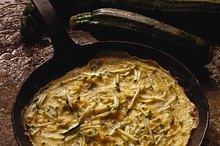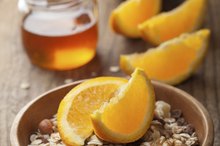What does fact checked mean?
At Healthfully, we strive to deliver objective content that is accurate and up-to-date. Our team periodically reviews articles in order to ensure content quality. The sources cited below consist of evidence from peer-reviewed journals, prominent medical organizations, academic associations, and government data.
The information contained on this site is for informational purposes only, and should not be used as a substitute for the advice of a professional health care provider. Please check with the appropriate physician regarding health questions and concerns. Although we strive to deliver accurate and up-to-date information, no guarantee to that effect is made.
What Can I Feed My Underweight 8-Month-Old?
If the weight-for-length calculation on your baby's growth chart drops below the fifth percentile, he is considered underweight. This means that more than 95 percent of babies his age weigh more than he does. Be sure to seek professional medical advice about your concerns regarding your baby’s weight, since there could be underlying problems that need to be addressed. If you're nursing, a referral to a lactation consultant or a feeding clinic might also be in order. If the doctor has already advised you to increase your baby's calories, there are foods and feeding methods that can help.
Infant Feeding
At around 6 months of age, the average baby will be drinking 24 to 32 ounces of formula or breast milk per day. Instead of increasing that intake, babies need to supplement it with solid foods. By 8 months of age, your baby should be eating solid foods a few times per day. Mealtime is the time to practice feeding skills, advance oral motor development, take in essential nutrients and add more calories for appropriate weight gain.
- At around 6 months of age, the average baby will be drinking 24 to 32 ounces of formula or breast milk per day.
- By 8 months of age, your baby should be eating solid foods a few times per day.
Feeding Methods
Are There Supplements for Weight Gain in Failure to Thrive?
Learn More
It’s beneficial to have focused feeding times as infants get older, especially if feeding difficulties are present. Instead of meal sessions that go on indefinitely, which can cause fatigue and frustration for both you and baby, try spending 20 to 30 minutes on feedings more frequently throughout the day. Offering a variety of foods at each meal and rotating through bites of each can increase the volume that babies and children eat in a sitting 1. Limit juice to 4 to 6 ounces per day to avoid hampering your baby’s appetite.
- It’s beneficial to have focused feeding times as infants get older, especially if feeding difficulties are present.
- Instead of meal sessions that go on indefinitely, which can cause fatigue and frustration for both you and baby, try spending 20 to 30 minutes on feedings more frequently throughout the day.
Calorie Boosting
Include plenty of variety in your baby’s diet. It can be tempting to provide desserts at each meal since they are high in calories, but there are foods within each group that promote weight gain while ensuring a balanced diet. Including a tablespoon of baby cereal in each meal provides extra calories and supplements essential nutrients such as iron. Baby cereal powder can be mixed with formula, breast milk or pureed foods. Read nutrition facts labels for calorie content of baby foods, and aim for 60 to 100 or more calories per serving for fruits and vegetables and 100 calories or more for meats and mixed dishes.
- Include plenty of variety in your baby’s diet.
- Including a tablespoon of baby cereal in each meal provides extra calories and supplements essential nutrients such as iron.
Commercial Options
How Many Calories Should a Baby Eat?
Learn More
Talk to your doctor about whether it would be appropriate to use commercial calorie boosters in foods or mix infant formula using a different recipe to make it higher in calories. Never mix your baby's formula to a different concentration than the one specified on the can unless a medical professional gives you specific instructions. Ask a dietitian for advice on products that can be mixed into your baby's foods to add calories from carbohydrate, fat, protein or a combination of these nutrients.
Related Articles
References
- UpToDate: Patient Information: Poor Weight Gain in Infants and Children (Beyond the Basics)
- MedlinePlus: Failure to Thrive
- Koplin JJ, Allen KJ, Gurrin LC, et al. The impact of family history of allergy on risk of food allergy: a population-based study of infants. Int J Environ Res Public Health. 2013;10(11):5364–5377. Published 2013 Oct 25. doi:10.3390/ijerph10115364
- American Academy of Pediatrics. Infant Food and Feeding. AAP.org. Published 2020.
- American Academy of Pediatrics. Committee on Nutrition. Hypoallergenic infant formulas. Pediatrics. 2000;106(2 Pt 1):346-9. doi:10.1542/peds.106.2.346
- Ferraro V, Zanconato S, Carraro S. Timing of Food Introduction and the Risk of Food Allergy. Nutrients. 2019;11(5):1131. Published 2019 May 21. doi:10.3390/nu11051131
- Cabana MD. The Role of Hydrolyzed Formula in Allergy Prevention. Ann Nutr Metab. 2017;70 Suppl 2:38-45. doi:10.1159/000460269
- National Collaborating Centre for Women's and Children's Health (UK). Identification and management of trigger factors. Atopic Eczema in Children: Management of Atopic Eczema in Children from Birth up to the Age of 12 Years. Published December 2007.
- Abeshu MA, Lelisa A, Geleta B. Complementary Feeding: Review of Recommendations, Feeding Practices, and Adequacy of Homemade Complementary Food Preparations in Developing Countries - Lessons from Ethiopia. Front Nutr. 2016;3:41. Published 2016 Oct 17. doi:10.3389/fnut.2016.00041
- Hagan JF, Shaw JS, Duncan PM. Bright Futures: Guidelines for Health Supervision of Infants, Children, and Adolescents. Elk Grove Village, IL: Bright Futures/American Academy of Pediatrics; 2017.
- NIAID-Sponsored Expert Panel, Boyce JA, Assa'ad A, et al. Guidelines for the diagnosis and management of food allergy in the United States: report of the NIAID-sponsored expert panel. J Allergy Clin Immunol. 2010;126(6 Suppl):S1–S58. doi:10.1016/j.jaci.2010.10.007
- Abrams EM, Becker AB. Food introduction and allergy prevention in infants. CMAJ. 2015;187(17):1297–1301. doi:10.1503/cmaj.150364
- Koo YC, Chang JS, Chen YC. Food claims and nutrition facts of commercial infant foods. PLoS One. 2018;13(2):e0191982. Published 2018 Feb 28. doi:10.1371/journal.pone.0191982
- Van den boom S, Kimber AC, Morgan JB. Nutritional composition of home-prepared baby meals in Madrid. Comparison with commercial products in Spain and home-made meals in England. Acta Paediatr. 1997;86(1):57-62. doi:10.1111/j.1651-2227.1997.tb08833.x
- Caffarelli C, Di Mauro D, Mastrorilli C, Bottau P, Cipriani F, Ricci G. Solid Food Introduction and the Development of Food Allergies. Nutrients. 2018;10(11):1790. Published 2018 Nov 17. doi:10.3390/nu10111790
- Kusari A, Han A, Eichenfield L. Recent advances in understanding and preventing peanut and tree nut hypersensitivity. F1000Res. 2018;7:F1000 Faculty Rev-1716. Published 2018 Oct 30. doi:10.12688/f1000research.14450.1
- Daniels L, Heath AL, Williams SM, et al. Baby-Led Introduction to SolidS (BLISS) study: a randomised controlled trial of a baby-led approach to complementary feeding. BMC Pediatr. 2015;15:179. Published 2015 Nov 12. doi:10.1186/s12887-015-0491-8
- Leung AK, Sauve RS. Whole cow's milk in infancy. Paediatr Child Health. 2003;8(7):419–421. doi:10.1093/pch/8.7.419
- Jeffery LA, Karim S. Botulism. [Updated 2019 Nov 30]. In: StatPearls [Internet]. Treasure Island (FL): StatPearls Publishing; 2019 Jan-.
- Nichols BG, Visotcky A, Aberger M, et al. Pediatric exposure to choking hazards is associated with parental knowledge of choking hazards. International Journal of Pediatric Otorhinolaryngology. 2012;76(2):169-173. doi:10.1016/j.ijporl.2011.10.018.
- Awadalla N, Pham T, Milanaik R. Chew on This: Not All First Finger Foods Are Created Equal. Clin Pediatr (Phila). 2018;57(8):889-894. doi: 10.1177/0009922817733701
- Chan ES, Abrams EM, Hildebrand KJ, Watson W. Early introduction of foods to prevent food allergy. Allergy Asthma Clin Immunol. 2018;14(Suppl 2):57. Published 2018 Sep 12. doi:10.1186/s13223-018-0286-1
- Nwaru BI, Erkkola M, Ahonen S, et al. Age at the Introduction of Solid Foods During the First Year and Allergic Sensitization at Age 5 Years. Pediatrics. 2009;125(1):50-59. doi:10.1542/peds.2009-0813.
Resources
Writer Bio
Andrea Abbe is a registered dietitian and licensed dietitian/nutritionist. She has served as a nutrition education coordinator in a public health program, a nutrition instructor and counselor for a corporate wellness program and a clinical dietitian for an academic medical center. Abbe holds a Bachelor of Science in dietetics.









